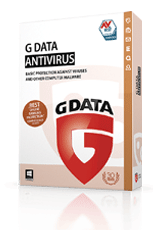G DATA Antivirus
How security should be: G DATA Antivirus reliably protects your PC against viruses - and your personal data during online banking transactions and shopping trips. So you no longer have to worry about the most common threats. New in this version of Antivirus is comprehensive exploit protection. This also safeguards your PC against malware that targets and exploits security vulnerabilities in your installed software.
